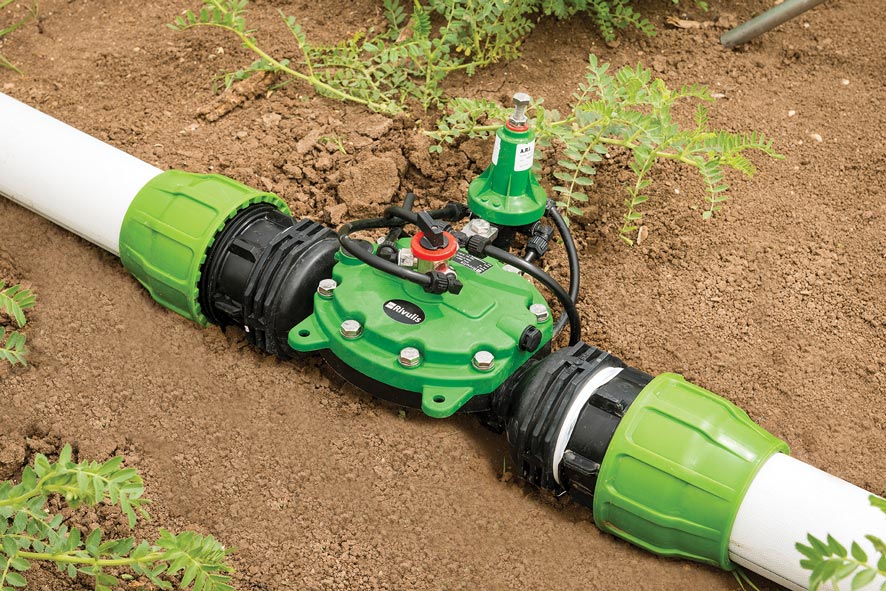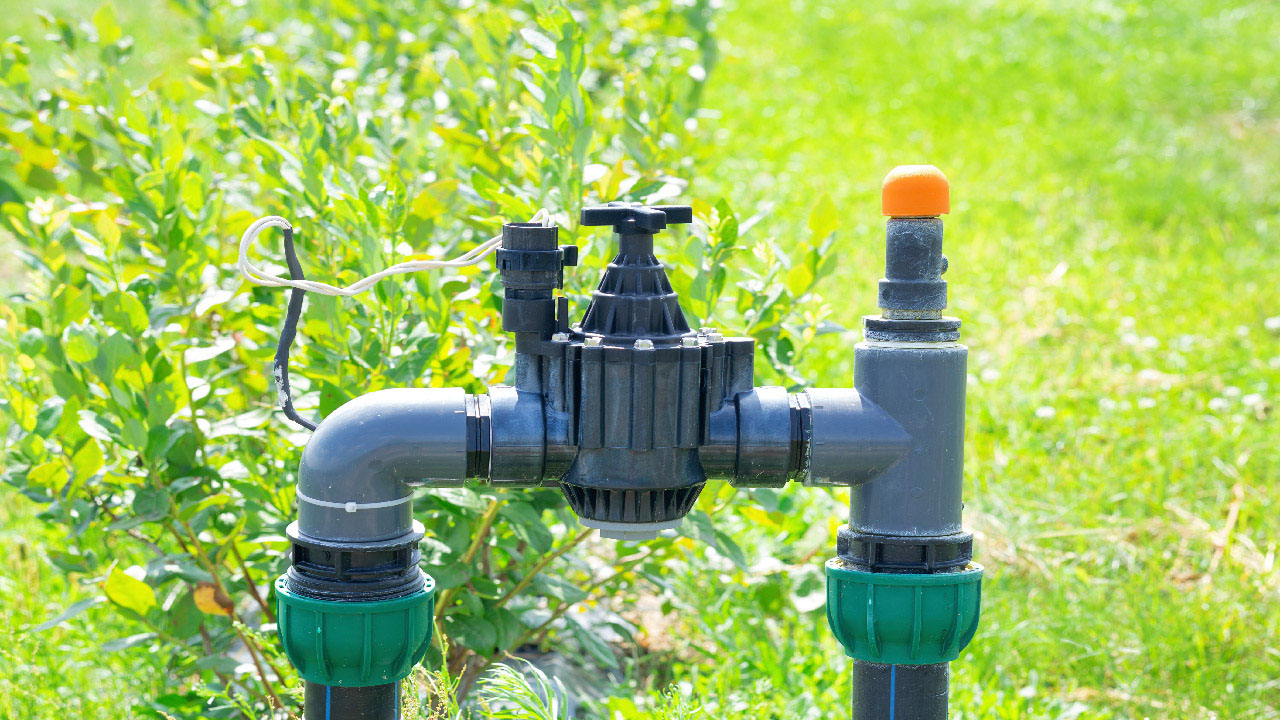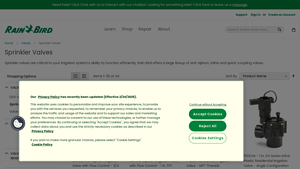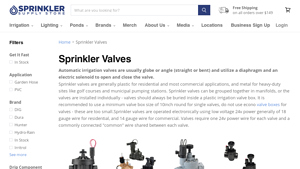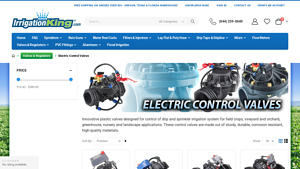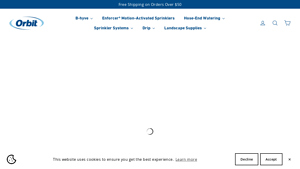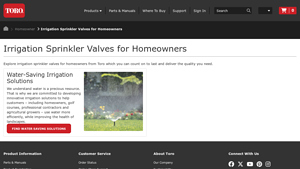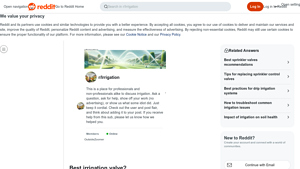Introduction: Navigating the Global Market for irrigation system control valves
In the ever-evolving landscape of agricultural technology, sourcing the right irrigation system control valves presents a significant challenge for international B2B buyers. With varying climates, water availability, and agricultural practices across regions such as Africa, South America, the Middle East, and Europe, selecting the appropriate control valves can determine the efficiency and sustainability of irrigation systems. This comprehensive guide delves into the diverse types of irrigation system control valves, their specific applications, and crucial factors for supplier vetting, enabling businesses to make informed purchasing decisions.
Throughout this guide, we explore the critical features of control valves—including anti-siphon, inline, and quick-coupling models—highlighting their roles in optimizing water management and preventing wastage. We will also address cost considerations, helping buyers navigate budgets while ensuring they receive high-quality products that meet regional demands.
By equipping international B2B buyers with actionable insights and practical knowledge, this guide empowers them to enhance their irrigation strategies. Whether in the lush fields of Brazil or the arid landscapes of the Middle East, making informed choices about irrigation system control valves is vital for maximizing yield and achieving sustainability. Embrace the potential of efficient irrigation systems and transform your agricultural practices with the right solutions at your fingertips.
Understanding irrigation system control valves Types and Variations
| Type Name | Key Distinguishing Features | Primary B2B Applications | Brief Pros & Cons for Buyers |
|---|---|---|---|
| Anti-Siphon Valves | Prevents backflow, typically installed above ground | Residential and commercial irrigation systems | Pros: Protects water quality; easy installation. Cons: Requires specific installation height. |
| Inline Valves | Integrated into the irrigation line, available in various sizes | Large-scale agricultural applications | Pros: Space-efficient; versatile; minimal disruption. Cons: More complex to install. |
| Electric Solenoid Valves | Operated electronically, often used with timers | Automated irrigation systems | Pros: Remote control; precise water management. Cons: Requires electrical setup and maintenance. |
| Manual Control Valves | Operated by hand, simple design | Small gardens and DIY projects | Pros: Low cost; straightforward operation. Cons: Labor-intensive; not automated. |
| Pressure Regulating Valves | Controls water pressure to prevent system damage | High-pressure areas and sensitive crops | Pros: Protects irrigation systems; ensures uniform flow. Cons: Can be more expensive; requires calibration. |
What are the Characteristics and Suitability of Anti-Siphon Valves?
Anti-siphon valves are designed to prevent backflow in irrigation systems, protecting the water supply from contamination. Typically installed above ground, these valves are crucial for residential and commercial applications where water quality is paramount. When considering B2B purchases, buyers should assess installation requirements, as these valves must be positioned at least six inches above the highest sprinkler head to function correctly. Their straightforward installation and ability to safeguard water supply make them a popular choice.
How Do Inline Valves Benefit Large-Scale Agricultural Applications?
Inline valves are integrated directly into the irrigation lines, providing a seamless solution for large-scale agricultural applications. Their design minimizes space usage and reduces soil disruption during installation. B2B buyers should consider the specific size and flow requirements of their systems, as inline valves come in various configurations to suit different needs. While they offer versatility and efficiency, the complexity of installation may necessitate professional assistance, which can increase initial costs.
Why Choose Electric Solenoid Valves for Automated Irrigation?
Electric solenoid valves are a key component in automated irrigation systems, allowing for remote control and precise water management. These valves are typically used in conjunction with timers, enabling users to schedule watering times effectively. B2B buyers should evaluate their electrical infrastructure, as proper setup and maintenance are essential for optimal performance. While the initial investment may be higher, the long-term benefits of reduced labor and improved water efficiency can justify the cost.
What Are the Advantages of Manual Control Valves?
Manual control valves are among the simplest types of irrigation valves, requiring direct hand operation. They are ideal for small gardens and DIY projects where automated solutions are unnecessary. B2B buyers should consider the labor involved in using these valves, as they require more hands-on management compared to automated options. Despite their low cost and ease of use, manual control valves may not be suitable for larger operations that demand efficiency and labor reduction.
How Do Pressure Regulating Valves Enhance Irrigation Systems?
Pressure regulating valves are essential for controlling water pressure in irrigation systems, particularly in areas with high pressure that can damage equipment. These valves ensure a consistent flow rate, making them vital for sensitive crops that require uniform watering. B2B buyers should assess the specific pressure needs of their irrigation setup, as these valves can be more expensive and require calibration for optimal performance. Their ability to protect irrigation systems and enhance water efficiency makes them a worthwhile investment for serious agricultural operations.
Key Industrial Applications of irrigation system control valves
| Industry/Sector | Specific Application of Irrigation System Control Valves | Value/Benefit for the Business | Key Sourcing Considerations for this Application |
|---|---|---|---|
| Agriculture | Automated irrigation systems for crop management | Enhanced water efficiency and reduced labor costs | Compatibility with existing systems, flow rate needs |
| Landscape Management | Sprinkler systems for parks and recreational areas | Improved aesthetics and plant health, water savings | Durability against weather conditions, ease of maintenance |
| Horticulture | Greenhouse irrigation control | Precise water delivery, optimized growth conditions | Customization for different plant types, pressure requirements |
| Industrial Facilities | Cooling water systems for manufacturing processes | Efficient resource management, cost savings | Flow control specifications, regulatory compliance |
| Municipal Water Systems | Water distribution in urban landscapes | Reliable water supply management, reduced wastage | Sizing for large-scale systems, anti-siphon features |
How Are Irrigation System Control Valves Used in Agriculture?
In agriculture, irrigation system control valves are integral to automated irrigation systems that manage water delivery based on crop requirements. These valves enable precise control over water flow, ensuring that crops receive adequate moisture while minimizing waste. By automating irrigation, farmers can significantly reduce labor costs and enhance water efficiency, which is crucial in regions facing water scarcity. International buyers should consider the compatibility of these valves with existing irrigation systems and specific flow rate needs to optimize performance.
What Role Do Control Valves Play in Landscape Management?
In landscape management, control valves are used in sprinkler systems to maintain the health and aesthetics of parks and recreational areas. These valves regulate water flow to ensure that landscaping features receive the right amount of water, preventing overwatering or underwatering. This not only enhances plant health but also leads to significant water savings. Buyers should prioritize sourcing valves that are durable enough to withstand diverse weather conditions and are easy to maintain to ensure long-term functionality.
How Are Control Valves Applied in Horticulture?
In horticulture, irrigation system control valves are essential for managing water delivery in greenhouses. These valves allow for precise control over irrigation schedules, tailored to the specific needs of various plants. By optimizing water conditions, growers can enhance plant health and yield, which is vital for competitive pricing in the market. Buyers in this sector should focus on customizable solutions that can accommodate different plant types and specific pressure requirements to maximize growth potential.
How Do Control Valves Benefit Industrial Facilities?
Industrial facilities utilize irrigation system control valves in cooling water systems essential for manufacturing processes. These valves help manage water flow efficiently, ensuring that machinery operates within safe temperature ranges while minimizing resource waste. Effective water management leads to significant cost savings for businesses. When sourcing valves for industrial applications, companies should consider the specifications for flow control and ensure compliance with relevant regulations to avoid operational disruptions.
What Is the Importance of Control Valves in Municipal Water Systems?
Municipal water systems rely on irrigation system control valves to regulate water distribution across urban landscapes. These valves ensure a reliable supply of water while effectively managing waste. In regions prone to drought or with limited water resources, implementing efficient irrigation systems becomes even more critical. Buyers should focus on sourcing appropriately sized valves for large-scale applications and prioritize features such as anti-siphon capabilities to prevent contamination and ensure public health.
3 Common User Pain Points for ‘irrigation system control valves’ & Their Solutions
Scenario 1: Difficulty in Maintaining Optimal Water Flow Rates
The Problem: B2B buyers often face challenges in maintaining optimal water flow rates through irrigation systems due to inconsistent valve performance. This inconsistency can lead to overwatering or underwatering specific zones, negatively affecting crop yield and increasing operational costs. For example, a large agricultural operation may find that some areas are receiving too much water, resulting in soil saturation and root rot, while others remain dry, affecting plant health. This issue can stem from improper valve selection, wear and tear, or inadequate system design.
The Solution: To mitigate these issues, buyers should prioritize sourcing high-quality control valves designed for adjustable flow rates. When selecting valves, it’s essential to consider the specific needs of the irrigation system, including the type of crops, soil conditions, and local climate. Opt for valves with built-in flow control features, such as adjustable flow knobs, which allow for precise management of water delivery. Additionally, routine maintenance checks should be performed to ensure that valves are functioning properly and are free from debris. Buyers should also consider investing in smart irrigation technology that automates flow adjustments based on real-time data, ensuring optimal water usage across all zones.
Scenario 2: Risk of Backflow and Contamination in Irrigation Systems
The Problem: Another common pain point for B2B buyers is the risk of backflow, which can lead to contamination of the water supply. This issue is particularly prevalent in regions where irrigation systems draw from shared water sources, raising health and environmental concerns. For instance, if an anti-siphon valve fails, it could allow contaminated water to flow back into the main supply, posing risks to crops and potentially violating regulatory standards.
The Solution: To address backflow issues, buyers should prioritize the installation of anti-siphon valves that prevent the reverse flow of water. These valves should be installed at least six inches above the highest sprinkler head to ensure proper functioning. Additionally, regular testing and maintenance of backflow prevention devices are crucial to ensure they are operational. Buyers can also benefit from consulting with irrigation specialists to conduct a comprehensive assessment of their system and identify potential vulnerabilities. Investing in high-quality, certified valves from reputable manufacturers can provide peace of mind regarding compliance and safety.
Scenario 3: Complications in Installation and System Integration
The Problem: Many B2B buyers encounter complications during the installation and integration of irrigation control valves with existing systems. These challenges can arise from a lack of compatibility between different valve types, leading to inefficiencies and increased installation costs. For example, a buyer might purchase a valve that does not fit the existing piping or requires additional components, resulting in delays and unexpected expenses.
The Solution: To streamline the installation process, buyers should conduct thorough compatibility checks before purchasing irrigation control valves. This includes verifying the specifications of existing pipes and fittings, as well as understanding the system layout. Buyers should consider modular valve systems that offer flexibility for future expansions or adjustments. Collaborating with experienced irrigation professionals during the planning phase can help identify potential integration issues early on. Furthermore, investing in comprehensive installation guides or professional services can minimize complications and ensure a smoother installation process. By taking these proactive steps, buyers can enhance the efficiency of their irrigation systems from the outset.
Strategic Material Selection Guide for irrigation system control valves
What Are the Key Materials Used in Irrigation System Control Valves?
When selecting materials for irrigation system control valves, it is crucial to consider various factors such as performance properties, durability, and compatibility with specific applications. Below is an analysis of four common materials used in the manufacturing of these valves: brass, PVC, stainless steel, and polyethylene.
How Does Brass Perform in Irrigation System Control Valves?
Brass is a popular choice for irrigation system control valves due to its excellent corrosion resistance and durability. It can withstand high pressures and temperatures, making it suitable for various irrigation applications. Brass valves typically have a pressure rating of up to 200 psi and can operate effectively in temperatures ranging from -20°F to 180°F.
Pros: Brass is highly durable and resistant to corrosion, which extends the life of the valve. It also has good thermal conductivity, which can be beneficial in systems requiring temperature regulation.
Cons: The primary drawback of brass is its cost, which is generally higher than plastic alternatives. Additionally, brass can be susceptible to dezincification in certain water conditions, leading to potential failures.
Impact on Application: Brass is compatible with potable water systems, making it ideal for agricultural and residential irrigation. However, buyers must ensure compliance with local regulations regarding lead content in drinking water.
What Are the Benefits of Using PVC for Control Valves?
Polyvinyl chloride (PVC) is widely used in irrigation systems due to its lightweight nature and resistance to corrosion and chemicals. PVC valves are typically rated for pressures up to 150 psi and can handle temperatures up to 140°F.
Pros: PVC is cost-effective and easy to install, making it a favorite among contractors. Its resistance to chemicals also makes it suitable for various irrigation applications, including those involving fertilizers.
Cons: PVC can become brittle over time, especially when exposed to UV light, which can lead to cracking. It also has a lower pressure and temperature rating compared to brass and stainless steel.
Impact on Application: PVC is suitable for non-potable water applications and is often used in agricultural irrigation systems. Buyers should consider local standards for chemical compatibility and UV resistance.
Why Choose Stainless Steel for Irrigation Control Valves?
Stainless steel is known for its exceptional strength and corrosion resistance, making it an excellent choice for irrigation control valves exposed to harsh environments. It typically has a pressure rating of up to 300 psi and can operate in a wide temperature range.
Pros: The durability of stainless steel ensures a long lifespan, even in aggressive environments. It is also easy to clean and maintain, which is essential for systems that may encounter sediment or debris.
Cons: The higher cost of stainless steel can be a barrier for some buyers. Additionally, its weight can complicate installation compared to lighter materials like PVC.
Impact on Application: Stainless steel is suitable for both potable and non-potable water applications, making it versatile for various irrigation needs. Buyers should verify compliance with international standards for food-grade materials.
What Role Does Polyethylene Play in Irrigation Systems?
Polyethylene is another commonly used material for irrigation system control valves, particularly in low-pressure applications. It is lightweight, flexible, and resistant to chemicals, making it ideal for agricultural use.
Pros: Polyethylene is cost-effective and offers excellent resistance to corrosion and chemicals. Its flexibility allows for easy installation in various terrains.
Cons: Polyethylene valves generally have lower pressure ratings (up to 100 psi) and may not perform well in high-temperature environments. They can also be susceptible to UV degradation if not properly protected.
Impact on Application: Polyethylene is ideal for drip irrigation systems and other low-pressure applications. Buyers should ensure that the material meets local agricultural standards for chemical use.
Summary Table of Material Selection for Irrigation System Control Valves
| Material | Typical Use Case for irrigation system control valves | Key Advantage | Key Disadvantage/Limitation | Relative Cost (Low/Med/High) |
|---|---|---|---|---|
| Brass | Potable water systems and high-pressure applications | Excellent durability and corrosion resistance | Higher cost and potential dezincification | High |
| PVC | Non-potable water applications in agriculture | Cost-effective and easy to install | Brittle over time, lower pressure rating | Low |
| Stainless Steel | Potable and non-potable applications in harsh environments | Exceptional strength and long lifespan | Higher cost and heavier than alternatives | High |
| Polyethylene | Drip irrigation and low-pressure systems | Flexible and resistant to chemicals | Lower pressure rating and UV degradation risk | Low |
This guide provides a comprehensive overview of the materials used in irrigation system control valves, enabling international B2B buyers to make informed decisions based on their specific needs and local regulations.
In-depth Look: Manufacturing Processes and Quality Assurance for irrigation system control valves
What Are the Main Stages of Manufacturing Irrigation System Control Valves?
The manufacturing process for irrigation system control valves consists of several critical stages that ensure the final product meets industry standards and customer expectations.
Material Preparation: How Are Raw Materials Selected and Processed?
The first stage involves the selection and preparation of raw materials, which typically include brass, PVC, or high-grade plastics. These materials are chosen for their durability, resistance to corrosion, and ability to withstand various environmental conditions. Once selected, the materials undergo processes such as cutting, machining, or extrusion to achieve the necessary shapes and sizes. This stage is crucial as it lays the foundation for the valve’s performance and longevity.
What Techniques Are Used in the Forming Stage?
The forming stage involves shaping the prepared materials into the components of the control valves. Common techniques include injection molding for plastic parts and CNC machining for metal components. Injection molding allows for high precision and uniformity, while CNC machining provides flexibility in creating complex designs. This stage also includes processes like forging and casting for specific components, depending on the valve’s intended use and design specifications.
How Is Assembly Performed in the Manufacturing Process?
Once individual components are formed, they proceed to the assembly stage. This involves fitting together various parts, such as the valve body, diaphragm, and actuator. The assembly is often performed in a clean environment to prevent contamination, which could affect the valve’s performance. Automated assembly lines may be employed for high-volume production, while manual assembly is common for specialized or low-volume orders. The assembly process is closely monitored to ensure that all components fit correctly and operate smoothly.
What Finishing Processes Enhance the Quality of Control Valves?
Finishing processes are essential for enhancing the durability and aesthetic appeal of irrigation system control valves. This stage may include surface treatments like plating, painting, or coating to provide additional protection against corrosion and wear. Quality checks are integrated into the finishing process to ensure that the valves meet the required specifications and standards before they are packaged and shipped.
What Quality Assurance Standards Are Relevant for Irrigation System Control Valves?
Quality assurance is paramount in manufacturing irrigation system control valves to ensure reliability and performance in the field. Various international and industry-specific standards guide these processes.
How Does ISO 9001 Influence Quality Control?
ISO 9001 is an internationally recognized standard for quality management systems. Manufacturers of irrigation control valves often implement ISO 9001 to demonstrate their commitment to quality. This standard requires organizations to establish a systematic approach to managing their processes, which includes regular audits and continuous improvement initiatives. Compliance with ISO 9001 assures B2B buyers that the manufacturer adheres to rigorous quality management practices.
What Industry-Specific Certifications Should B2B Buyers Look For?
In addition to ISO 9001, industry-specific certifications such as CE marking (for compliance with European health, safety, and environmental protection standards) and API (American Petroleum Institute) standards may also be relevant. These certifications indicate that the valves meet specific safety and performance criteria, which is particularly important in regions where regulatory compliance is strictly enforced.
What Are the Key QC Checkpoints During Manufacturing?
Quality Control (QC) is integrated at various checkpoints throughout the manufacturing process to identify and rectify defects early on.
What Is In-Process Quality Control (IPQC)?
In-Process Quality Control (IPQC) is a crucial checkpoint that occurs during the manufacturing stages. This involves continuous monitoring of the production process, including regular inspections of materials, components, and assembly procedures. By implementing IPQC, manufacturers can promptly address any deviations from quality standards, thereby reducing the likelihood of defects in the final product.
How Do Incoming Quality Control (IQC) and Final Quality Control (FQC) Work?
Incoming Quality Control (IQC) ensures that raw materials meet the required specifications before they enter the production process. This is vital for maintaining the quality of the finished product. Final Quality Control (FQC), on the other hand, occurs after the assembly and finishing stages. FQC involves comprehensive testing of the completed valves to assess their functionality, pressure tolerance, and durability. Common testing methods include hydrostatic testing, which checks for leaks, and functional testing, which ensures that the valves operate correctly under simulated conditions.
How Can B2B Buyers Verify Supplier Quality Control?
B2B buyers, particularly those sourcing from international suppliers, should take proactive steps to verify the quality control measures of their manufacturers.
What Role Do Audits and Reports Play in Supplier Verification?
Conducting audits is a fundamental way for buyers to assess a supplier’s quality control processes. Regular audits can reveal insights into the manufacturing environment, adherence to quality standards, and overall operational practices. Buyers should also request quality control reports that detail the results of inspections and tests performed on the valves. These documents provide transparency and assurance regarding the quality of the products.
How Can Third-Party Inspections Enhance Confidence in Supplier Quality?
Engaging third-party inspection services adds an additional layer of assurance for B2B buyers. Independent inspectors can conduct unbiased evaluations of the manufacturing process, including material sourcing, production practices, and finished product testing. This not only helps in confirming compliance with international standards but also mitigates the risks associated with international sourcing.
What Are the QC Nuances for International B2B Buyers?
When sourcing irrigation system control valves from international suppliers, buyers must navigate various quality control nuances.
How Do Regional Regulations Affect Quality Assurance?
Different regions may have specific regulations governing the quality and safety of irrigation products. For instance, European buyers must ensure compliance with CE marking requirements, while buyers in the Middle East may need to adhere to local standards that may differ from international norms. Understanding these regional regulations is crucial for successful procurement and market entry.
What Should Buyers Consider Regarding Supply Chain Transparency?
Supply chain transparency is another vital consideration for B2B buyers. Understanding the entire supply chain—from raw material sourcing to manufacturing and delivery—enables buyers to assess potential risks and ensure that all components meet the required quality standards. Engaging with suppliers who prioritize transparency fosters trust and long-term partnerships.
In summary, the manufacturing processes and quality assurance practices for irrigation system control valves are complex but essential for ensuring product reliability and performance. B2B buyers must be diligent in evaluating their suppliers, understanding relevant standards, and implementing thorough verification processes to safeguard their investments.
Practical Sourcing Guide: A Step-by-Step Checklist for ‘irrigation system control valves’
Introduction
Navigating the procurement of irrigation system control valves can be complex, especially for international B2B buyers. This checklist serves as a practical guide to streamline the sourcing process, ensuring that you make informed decisions that meet your operational needs and budget constraints.
Step 1: Define Your Technical Specifications
Understanding the technical requirements of your irrigation system is essential before sourcing valves. Identify the types of valves needed—such as anti-siphon, inline, or quick-coupling—and their specifications, including size, flow rate, and pressure ratings. This clarity will help you communicate effectively with suppliers and ensure compatibility with existing systems.
Step 2: Research and Identify Potential Suppliers
Conduct thorough research to compile a list of potential suppliers. Look for manufacturers and distributors known for quality irrigation products, paying attention to their reputation in the market. Utilize industry-specific platforms, trade shows, and online directories to gather information and identify suppliers with a strong presence in your target regions.
Step 3: Evaluate Supplier Certifications and Compliance
Before proceeding with a supplier, verify their certifications and compliance with international standards. This includes checking for ISO certifications and adherence to local regulations, which can vary significantly across regions like Africa, South America, the Middle East, and Europe. Suppliers meeting these standards are more likely to provide reliable products and services.
Step 4: Request Samples and Technical Documentation
Request samples of the valves you are considering, along with technical documentation. This allows you to assess the product’s quality and functionality firsthand. Pay attention to the materials used, ease of installation, and any specific features such as flow control or anti-siphon capabilities that may impact performance.
Step 5: Compare Pricing and Payment Terms
Once you have a shortlist of suppliers, compare pricing structures and payment terms. Look for transparency in pricing and any hidden costs related to shipping, customs, or additional services. Favor suppliers who offer flexible payment terms that align with your budget and cash flow requirements.
Step 6: Assess After-Sales Support and Warranty Policies
Strong after-sales support is critical for ensuring the longevity and performance of your irrigation system. Inquire about warranty policies and the availability of customer support for troubleshooting and maintenance. A supplier that provides robust after-sales assistance can save you time and resources in the long run.
Step 7: Finalize the Order and Confirm Delivery Logistics
After selecting a supplier, finalize your order details, including quantities and delivery timelines. Confirm logistics to ensure that the valves will arrive on schedule and in good condition. Discuss potential issues related to customs clearance and ensure that all necessary documentation is in place to facilitate a smooth delivery process.
By following this checklist, B2B buyers can navigate the complexities of sourcing irrigation system control valves, ensuring they select the right products and partners for their specific needs.
Comprehensive Cost and Pricing Analysis for irrigation system control valves Sourcing
What Are the Key Cost Components in Irrigation System Control Valves?
When sourcing irrigation system control valves, understanding the cost structure is essential. The primary cost components include:
Materials: The choice of materials significantly impacts the overall cost. Common materials include plastic, brass, and stainless steel, with plastics generally being more cost-effective but potentially less durable than metals. The material selected will influence both the initial purchase price and the longevity of the valve.
Labor: Labor costs vary depending on the region and the complexity of the manufacturing process. Automated production may reduce labor costs, but regions with higher wage standards could see increased expenses.
Manufacturing Overhead: This encompasses costs related to utilities, equipment maintenance, and factory operations. Efficient production processes can help minimize overhead costs, thus impacting the final pricing.
Tooling: The initial investment in tooling can be substantial, especially for custom or specialized valves. This cost is typically amortized over the production run, affecting the price per unit.
Quality Control (QC): Ensuring that valves meet regulatory and performance standards is critical. Rigorous QC processes can add to the cost but are essential for maintaining reliability and safety.
Logistics: Shipping and handling costs vary based on the supplier’s location and the destination. International shipping may include tariffs and customs duties, which should be factored into the total cost.
Margin: Suppliers will typically mark up the base cost to achieve their desired profit margin. Understanding the market can help buyers gauge whether the pricing is reasonable.
How Do Price Influencers Affect Irrigation System Control Valves?
Several factors influence the pricing of irrigation system control valves:
Volume/MOQ: Suppliers often offer discounts for bulk purchases. Understanding the minimum order quantity (MOQ) can help buyers negotiate better pricing.
Specifications/Customization: Custom valves tailored to specific needs may incur additional costs. Standard models generally offer lower prices, so evaluating the necessity of custom features is crucial.
Materials: As noted, the choice of materials affects pricing. More durable materials may have a higher upfront cost but could result in lower long-term costs due to reduced replacement frequency.
Quality/Certifications: Valves that meet specific industry standards or certifications may come at a premium. However, investing in higher quality can lead to improved performance and reliability.
Supplier Factors: The reputation and reliability of the supplier can also affect pricing. Established suppliers may charge more, but they often provide better service and warranties.
Incoterms: Understanding the terms of delivery (Incoterms) is vital. They define the responsibilities of buyers and sellers regarding shipping costs and risks, which can significantly impact total costs.
What Are Effective Buyer Tips for Sourcing Control Valves?
For international B2B buyers, especially in regions like Africa, South America, the Middle East, and Europe, consider the following tips:
Negotiate Wisely: Leverage bulk purchasing or long-term contracts to negotiate better pricing. Building a relationship with suppliers can also result in more favorable terms.
Focus on Cost-Efficiency: Evaluate the total cost of ownership (TCO) rather than just the purchase price. This includes maintenance costs, longevity, and the potential for reduced downtime.
Understand Pricing Nuances: Be aware of regional pricing trends and factors that may affect costs, such as local labor rates or material availability. This knowledge can empower buyers in negotiations.
Consider Local Suppliers: Sourcing from local suppliers can reduce shipping costs and lead times. Additionally, local suppliers may offer insights into regional compliance and standards.
Request Samples: Before committing to large orders, request samples to assess quality and compatibility with existing systems. This practice helps mitigate the risk of costly mistakes.
In summary, careful consideration of cost components, price influencers, and strategic buying practices can lead to significant savings and improved outcomes in sourcing irrigation system control valves. Understanding these factors is crucial for making informed purchasing decisions in a competitive global market.
Alternatives Analysis: Comparing irrigation system control valves With Other Solutions
Understanding Alternatives to Irrigation System Control Valves
In the landscape of irrigation technology, various solutions exist to optimize water management and distribution. While irrigation system control valves are essential for regulating water flow and pressure in irrigation setups, alternative technologies and methods can also achieve similar goals. This section explores two viable alternatives: drip irrigation systems and automated irrigation controllers, providing a comprehensive comparison to assist B2B buyers in making informed decisions.
| Comparison Aspect | Irrigation System Control Valves | Drip Irrigation Systems | Automated Irrigation Controllers |
|---|---|---|---|
| Performance | Highly effective in regulating flow and pressure; suitable for various systems | Excellent for targeted watering; minimizes water wastage | Allows for precise scheduling and adjustments based on weather conditions |
| Cost | Moderate initial investment; ongoing maintenance costs | Generally lower installation costs; but may require more components | Higher upfront cost; cost-effective in the long run due to water savings |
| Ease of Implementation | Relatively straightforward installation; requires some plumbing skills | Can be complex depending on layout; requires planning for placement | User-friendly installation; often involves software setup |
| Maintenance | Requires regular checks and potential replacements | Minimal maintenance; occasional checks for clogs | Low maintenance; software updates may be needed |
| Best Use Case | Ideal for large-scale agricultural operations needing flow regulation | Best suited for gardens and crops needing precise watering | Most effective in areas with variable weather; ideal for urban gardens |
What Are the Advantages and Disadvantages of Drip Irrigation Systems?
Drip irrigation systems deliver water directly to the base of plants through a network of tubing and emitters. This method is particularly advantageous for water conservation, as it minimizes evaporation and runoff. However, the complexity of installation can be a drawback, especially for large areas requiring extensive layouts. Additionally, drip systems can be susceptible to clogging, necessitating regular maintenance checks to ensure optimal performance.
How Do Automated Irrigation Controllers Enhance Irrigation Efficiency?
Automated irrigation controllers are devices that manage watering schedules based on environmental factors like soil moisture and weather forecasts. These systems offer high precision, allowing users to customize watering times and amounts, thus promoting water efficiency. The initial investment in automated controllers can be higher than traditional methods; however, the long-term savings on water costs often justify the expense. Their ease of use and minimal maintenance requirements make them an attractive option for both residential and commercial applications.
Conclusion: How to Choose the Right Irrigation Solution for Your Needs?
When selecting the right irrigation solution, B2B buyers should consider their specific operational needs, budget constraints, and the environmental context of their projects. Irrigation system control valves are well-suited for large agricultural setups that require robust flow regulation. In contrast, drip irrigation systems excel in scenarios demanding precise watering, making them ideal for gardens and smaller crop areas. Automated irrigation controllers offer flexibility and efficiency, particularly beneficial in regions with fluctuating weather patterns. Ultimately, the choice should align with the operational goals, water conservation strategies, and maintenance capabilities of the buyer’s irrigation system.
Essential Technical Properties and Trade Terminology for irrigation system control valves
What Are the Key Technical Properties of Irrigation System Control Valves?
Understanding the essential technical properties of irrigation system control valves is crucial for making informed purchasing decisions. Here are several critical specifications that buyers should consider:
Material Grade
The material of the valve significantly affects its durability and performance. Common materials include brass, PVC, and high-density polyethylene (HDPE). Brass valves are known for their longevity and resistance to corrosion, making them ideal for harsh environments. PVC and HDPE are lightweight and cost-effective, suitable for less demanding applications. Selecting the right material ensures that the valve can withstand specific environmental conditions and water quality.Pressure Rating
This specification indicates the maximum pressure the valve can handle, typically measured in pounds per square inch (PSI). Irrigation systems often operate at varying pressures, and understanding the pressure rating helps prevent system failures. A valve with a higher pressure rating can accommodate more extensive systems or fluctuating water supply conditions, making it a valuable choice for B2B buyers in diverse geographical regions.Flow Rate
The flow rate, usually expressed in gallons per minute (GPM), defines how much water can pass through the valve in a given time. This specification is critical for ensuring that the irrigation system meets the specific needs of the landscape or agricultural area. Choosing a valve with an appropriate flow rate optimizes water efficiency and ensures uniform coverage, which is particularly important in regions facing water scarcity.Electrical Specifications
For electrically operated valves, understanding voltage requirements (e.g., 24V AC or DC) and compatibility with irrigation timers is essential. This ensures that the valve can be integrated seamlessly into existing systems. B2B buyers should also consider features like solenoid type and energy efficiency, as these factors influence overall operational costs.Size and Connection Type
The valve’s size (e.g., ¾ inch or 1 inch) and the type of connections (e.g., threaded, slip) are critical for compatibility with existing irrigation infrastructure. Correct sizing and connection types facilitate easy installation and maintenance. This is particularly significant for international buyers who may face varying standards in different regions.Backflow Prevention Features
Many irrigation valves come with built-in backflow prevention to protect the water supply from contamination. Understanding these features is vital for compliance with local regulations and ensuring safe water use. This is especially relevant for agricultural businesses and municipalities where water quality is paramount.
What Are Common Trade Terms in the Irrigation Valve Industry?
Familiarity with industry jargon can streamline communication and improve negotiations. Here are some essential terms:
OEM (Original Equipment Manufacturer)
OEM refers to companies that produce parts or equipment that may be marketed by another manufacturer. In the context of irrigation valves, knowing if a product is OEM can assure buyers of its quality and compatibility with existing systems.MOQ (Minimum Order Quantity)
MOQ is the minimum number of units a supplier requires for a purchase order. Understanding MOQ is crucial for B2B buyers, particularly those managing budgets and inventory levels, as it can impact cash flow and stock management.RFQ (Request for Quotation)
An RFQ is a formal process where buyers request pricing and terms from suppliers for specific products. Initiating an RFQ can help businesses secure competitive pricing and better understand the market landscape.Incoterms (International Commercial Terms)
Incoterms are standardized trade terms that define the responsibilities of buyers and sellers in international transactions, including shipping, insurance, and tariffs. Familiarity with these terms helps buyers mitigate risks and clarify expectations.Lead Time
Lead time refers to the time it takes from placing an order to receiving the product. Understanding lead times is essential for project planning and ensuring timely delivery of irrigation systems, which can be critical in agricultural cycles.Warranty and Support Terms
Warranty terms describe the conditions under which a product can be returned or repaired. Buyers should be aware of these terms to ensure they receive adequate support and protection for their investments.
By grasping these technical properties and trade terms, B2B buyers can make more informed decisions, optimize their irrigation systems, and build successful supplier relationships.
Navigating Market Dynamics and Sourcing Trends in the irrigation system control valves Sector
What Are the Current Market Dynamics and Trends in the Irrigation System Control Valves Sector?
The irrigation system control valves market is experiencing robust growth driven by various global factors. Increasing agricultural demands, especially in developing regions such as Africa and South America, are pushing the need for efficient irrigation solutions. The integration of technology in agriculture, particularly precision farming, is leading to a rise in smart irrigation systems that utilize control valves for automation and enhanced water management. Additionally, the growing focus on water conservation and efficient resource management is influencing purchasing decisions among B2B buyers.
Emerging trends include the adoption of IoT-enabled control valves, which allow for remote monitoring and management of irrigation systems. This technology is particularly appealing to international buyers looking to optimize their operations while reducing labor costs. Furthermore, the rise of e-commerce platforms has made sourcing these valves more accessible, allowing buyers from regions such as the Middle East and Europe to easily compare products and manufacturers. The demand for customized solutions, such as valves that can handle varying water pressures and flow rates, is also on the rise, reflecting a shift towards tailored agricultural practices.
How Are Sustainability and Ethical Sourcing Influencing the Irrigation System Control Valves Market?
Sustainability is becoming a critical factor in the procurement of irrigation system control valves. Buyers are increasingly aware of the environmental impact of their purchasing decisions, prompting a shift towards products that minimize ecological footprints. This includes sourcing valves made from recyclable materials or those that incorporate energy-efficient technologies. The emphasis on sustainable practices extends to the entire supply chain, with buyers seeking suppliers who adhere to ethical sourcing standards and demonstrate social responsibility.
Certifications such as ISO 14001 for environmental management and other “green” certifications are becoming essential criteria for B2B buyers. These certifications not only validate the environmental claims of manufacturers but also provide assurance regarding the sustainable practices of suppliers. Moreover, as regulatory frameworks around water usage tighten, manufacturers that prioritize sustainability are likely to gain a competitive edge in the market. Buyers are encouraged to evaluate suppliers based on their commitment to reducing waste and improving energy efficiency in their products.
What Is the Brief Evolution of Irrigation System Control Valves?
The evolution of irrigation system control valves has been shaped by technological advancements and changing agricultural needs. Initially, traditional manual valves were the norm, requiring labor-intensive operation and maintenance. However, as agricultural practices evolved, the demand for efficiency and automation led to the development of electric and solenoid-operated valves. These innovations allowed for better control of water flow and pressure, significantly improving irrigation efficiency.
In recent years, the incorporation of smart technology has revolutionized the sector, enabling remote operation and monitoring. This shift is not just about convenience; it reflects a broader trend towards precision agriculture, where data-driven decisions enhance crop yields and resource management. As the global market continues to grow, the evolution of control valves will likely focus on further integrating advanced technologies, such as AI and machine learning, to optimize irrigation practices even further. This ongoing transformation presents significant opportunities for international B2B buyers looking to invest in the future of agriculture.
Frequently Asked Questions (FAQs) for B2B Buyers of irrigation system control valves
How do I select the right control valve for my irrigation system?
Selecting the appropriate control valve depends on several factors, including the type of irrigation system, the water pressure, and flow rate requirements. Assess whether you need an anti-siphon valve to prevent backflow or a standard inline valve for straightforward applications. Additionally, consider the size of your piping; valves come in various diameters, and matching these to your system is crucial for efficiency. Consulting with suppliers about your specific needs can also lead to valuable recommendations tailored to your operational conditions.What is the best valve type for drip irrigation systems?
For drip irrigation systems, pressure-regulating valves are typically the best choice. They help maintain consistent water pressure, preventing damage to drip emitters and ensuring uniform water distribution. Anti-siphon valves are also recommended to prevent contamination of the water supply. When sourcing valves, look for those designed specifically for low-flow applications to maximize efficiency and reduce water wastage.What are common quality assurance practices for irrigation control valves?
Quality assurance for irrigation control valves involves several key practices, such as rigorous testing for flow rates, pressure endurance, and durability under various environmental conditions. Suppliers should provide certifications or compliance with industry standards, such as ISO or ASTM. Requesting samples for testing before bulk orders can also help ensure the product meets your specifications and quality expectations.How can I effectively vet suppliers of irrigation system control valves?
To vet suppliers, consider their reputation in the industry, customer reviews, and years of operation. Request references from previous clients and inquire about their experience with product quality and customer service. Additionally, assess their ability to provide timely delivery and support in your region, especially if you are sourcing from international markets. Conducting a thorough background check on the supplier’s financial stability can also mitigate risks associated with long-term partnerships.What customization options are typically available for irrigation control valves?
Many suppliers offer customization options for irrigation control valves, including specific sizes, materials, and features tailored to unique operational needs. Common customizations might include pressure ratings, flow control settings, or integration with existing irrigation systems. Discussing your requirements with suppliers can lead to tailored solutions that enhance the efficiency and effectiveness of your irrigation operations.What is the typical minimum order quantity (MOQ) for irrigation control valves?
The minimum order quantity (MOQ) for irrigation control valves varies by supplier and can depend on factors such as the type of valve and production capabilities. Generally, MOQs can range from a few dozen to several hundred units. When negotiating with suppliers, clarify the MOQ upfront and explore options for smaller orders if necessary, particularly for testing or initial project phases.What payment terms should I expect when sourcing internationally?
Payment terms for international orders can vary widely but often include options such as advance payment, letters of credit, or payment upon delivery. It’s essential to discuss and negotiate these terms before finalizing contracts. Consider using secure payment methods that offer buyer protection, especially when dealing with new suppliers. Additionally, understanding the currency exchange rates and potential fees associated with international transactions can help in budgeting effectively.What logistics considerations should I keep in mind when importing irrigation valves?
When importing irrigation valves, consider shipping options, customs regulations, and potential tariffs that may apply. Collaborate with logistics providers who have experience in handling agricultural equipment to ensure compliance with local regulations. Additionally, factor in lead times for shipping and customs clearance, as these can significantly affect project timelines. Planning for potential delays and maintaining clear communication with suppliers and logistics partners can help ensure a smooth import process.
Important Disclaimer & Terms of Use
⚠️ Important Disclaimer
The information provided in this guide, including content regarding manufacturers, technical specifications, and market analysis, is for informational and educational purposes only. It does not constitute professional procurement advice, financial advice, or legal advice.
While we have made every effort to ensure the accuracy and timeliness of the information, we are not responsible for any errors, omissions, or outdated information. Market conditions, company details, and technical standards are subject to change.
B2B buyers must conduct their own independent and thorough due diligence before making any purchasing decisions. This includes contacting suppliers directly, verifying certifications, requesting samples, and seeking professional consultation. The risk of relying on any information in this guide is borne solely by the reader.
Top 6 Irrigation System Control Valves Manufacturers & Suppliers List
1. Rain Bird – 075ASVF Anti-Siphon Valve
Domain: store.rainbird.com
Registered: 1995 (30 years)
Introduction: Rain Bird offers a variety of sprinkler valves including anti-siphon, inline, and quick-coupling types. Key products include: 075ASVF – 3/4 in. Plastic Residential Anti-Siphon Irrigation Valve with Flow Control ($28.38), 100ASVF – 1 in. Plastic Residential Anti-Siphon Irrigation Valve with Flow Control ($30.87), 100DV – 1 in. DV Series Inline Plastic Residential Irrigation Valve ($26.36), 100DVA -…
2. Sprinkler Supply Store – Free Delivery on Orders Over $149.90
Domain: sprinklersupplystore.com
Registered: 2010 (15 years)
Introduction: This company, Sprinkler Supply Store – Free Delivery on Orders Over $149.90, is a notable entity in the market. For specific product details, it is recommended to visit their website directly.
3. Irrigation King – Electric Control Valves
Domain: irrigationking.com
Registered: 2016 (9 years)
Introduction: Electric Control Valves designed for drip and sprinkler irrigation systems in various applications including field crops, vineyards, orchards, greenhouses, nurseries, and landscapes. Made from durable, corrosion-resistant materials. Available sizes and models include:
– BALDR 1-1/2″ Control Valve with 24V AC Solenoid – NPT (BV15ESC) – Special Price: $149.00 (was $259.26)
– BALDR 2″ Control Valve…
4. Orbit – Top Underground Valves for Sprinkler and Drip Systems
Domain: orbitonline.com
Registered: 1999 (26 years)
Introduction: Top Underground Valves for Sprinkler and Drip Systems
5. Toro – Irrigation Sprinkler Valves
Domain: toro.com
Registered: 1994 (31 years)
Introduction: Irrigation Sprinkler Valves for Homeowners from Toro are designed for durability and quality. Toro is committed to developing innovative water-saving irrigation solutions that help homeowners, golf courses, professional contractors, and agricultural growers use water more efficiently while improving landscape health.
6. Hunter – Top Service Repair Valve
Domain: reddit.com
Registered: 2005 (20 years)
Introduction: This company, Hunter – Top Service Repair Valve, is a notable entity in the market. For specific product details, it is recommended to visit their website directly.
Strategic Sourcing Conclusion and Outlook for irrigation system control valves
What Are the Key Takeaways for B2B Buyers of Irrigation Control Valves?
In summary, strategic sourcing of irrigation system control valves offers significant advantages for international buyers, particularly in regions like Africa, South America, the Middle East, and Europe. Understanding the diverse offerings—from anti-siphon to inline valves—enables buyers to make informed choices that enhance system efficiency and water conservation. Moreover, leveraging reliable suppliers with a reputation for quality can lead to long-term cost savings and improved operational performance.
How Can Buyers Enhance Their Procurement Strategy?
As the demand for sustainable and efficient irrigation solutions rises, investing in high-quality control valves becomes paramount. Buyers should prioritize suppliers who provide innovative features such as adjustable flow control and robust materials to withstand varying environmental conditions. By aligning procurement strategies with reliable manufacturers, businesses can ensure they are equipped with the latest technology and best practices in irrigation management.
What’s Next for the Future of Irrigation Systems?
Looking ahead, the landscape of irrigation technology will continue to evolve, driven by advancements in automation and smart irrigation solutions. International buyers are encouraged to stay abreast of these trends and actively seek partnerships that foster innovation. By adopting a proactive approach to sourcing, businesses can not only meet current irrigation needs but also position themselves for future growth and sustainability in agricultural practices.

